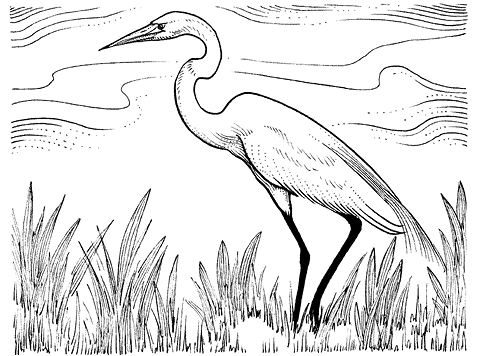Great Egret, Snowy Egret
Even though the egret is a type of heron, I have included it as a separate entry because of the ethereal and otherworldly energy of this bird, which differs from other herons. The name egret comes from the French aigrette, meaning “little heron.” 66 To the Maori people of New Zealand, seeing an egret was considered a great blessing. This is understandable to me, as I have felt fortunate whenever I have encountered these elegant birds while kayaking through our local marshes.
Throughout most of the year, the egret has a svelte appearance. However, during the breeding season, it develops long, wispy plumes that make it look shaggy. These temporary feathers are called nuptial plumes, and they were so much of a fashion rage in the late nineteenth and early twentieth centuries that the egret was hunted nearly to extinction. Founded to protect birds from being killed for their feathers or other frivolous uses, the National Audubon Society uses the great egret as its symbol.
According to wildlife biologist and nature writer Les Beletsky, the Egyptian hieroglyph that is interpreted as a phoenix actually depicts a bird that looks more like an egret or heron. Along with the crane, egrets were believed by the Celts to have a close affinity with the supernatural world. Although he was usually depicted as a woodsman, Esus, considered a fertility god by Continental Celts, was associated with egrets.
Magical Workings
Before embarking on astral travel, spirit communication, or any exploration of the otherworld call on egret to help bring you into stillness with its calm, grounding energy. This bird also provides guidance and protection between the worlds. Visualize holding one of its feathers as a talisman as you journey.
Draw on egret’s wisdom at Samhain to connect with ancestors as well as those who have more recently passed beyond the veil. This bird can help answer questions and carry messages between you and your loved one.
Egret’s beauty is symbolic of peace and stability. Meditating on its image conveys a deeply-rooted confidence that can serve as an aid for all of your endeavors.
Make Connection
Connect with the energy of egret by standing as still as you can while you imagine a thin, white, veil-like mist surrounding you. Feel the shimmering, ethereal quality of the mist enfolding you into a separate and magical realm. As the mist slightly parts, a brilliant white egret stands before you. It looks at you but does not move, only watches you with interest.
Reach forward toward one of its wings as you bow your head. If it brushes your hand with its bill, you will be allowed to touch it. When you make contact with the feathers, you will be filled with a sense of peace. Don’t be discouraged if it does not touch you the first time you seek connection. Egret may want to teach you patience and the art of coming into stillness.
Associations
Element(s): Air, earth, water
Sabbat(s): Samhain
God: Esus
Bird Identification
Great Egret (Ardea alba)
Size: 37 to 40 inches
Wingspan: 51 to 57 inches
Comparative size: Goose
Description: Tall and slender; all-white body; long, black legs; yellowish-orange, daggerlike bill; long, S-curved neck; long lacy plumes on back during breeding season
Range: Throughout most of the lower forty-eight except Rocky Mountain states and parts of California and the Pacific Northwest; throughout Mexico, Central America, and most of South America
Habitat: Fresh and saltwater marshes, marshy ponds, and marine wetlands
Eggs: Smooth, pale greenish blue
Snowy Egret (Egretta thula)
Size: 22 to 26 inches
Wingspan: 38 to 40 inches
Comparative size: Goose
Description: Small and delicate; all-white body; black bill with yellow patch of skin at the base; black legs; greenish-yellow feet that turn orange-yellow during breeding season; long lacy plumes on head, neck, and back during breeding season
Range: From northern California and east to New England; mainly on the coasts but also inland waters; south into Mexico and South America
Habitat: Fresh and saltwater marshes, ponds, swamps, and mudflats
Eggs: Pale greenish blue
Collective noun(s): A colony, a congregation, a heronry, a stand, or a wedge of egrets
66. Ian Fraser and Jeannie Gray, Australian Bird Names: A Complete Guide (Collingwood, Australia: CSIRO Publishing, 2013), 64.
